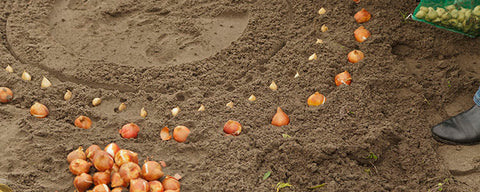Preparing your soil for flower bulb planting
Planting season is here! A busy and exciting time at DutchGrown. The coming weeks this blog will be giving you all the best insights, tips and information to ensure you get the best results come spring.
Board & lodging
For this blog we’re going deep. That is, deep into your garden’s soil, which is the home ánd the food of your flower bulbs. And just like everything else that you nurture and grow, you want their home to be the best home possible, and their food to give them all the nutrients they need. To grow and thrive us humans need healthy foods, 8 hours of sleep and minimal stress. But what do bulbs need?
Loose & drained
More than anything, bulbs need their soil to be well-drained, and ideally quite loose as well. Maybe you’ve already heard this a thousand times, but it’s important enough to repeat it again. But why is well-draining soil such a holy grail if we want to grow bulbs?
First of all, it lets the bulbs’ roots breathe. Bulbs need oxygen, and loose, well-drained soil holds little pockets of air between the soil particles, which help the roots to move around easily when they are trying to find the oxygen they need. Secondly, soil that is too wet will rot the bulbs, and suffocate its roots. Well-drained soil helps water drain away from the bulb, keeping it healthy. Thirdly, loose and well-drained soil is a welcoming home for beneficial soil life. Think of pill bugs, earthworms and tiny microbes, all working hard to convert organic matter into the nutrients and minerals your bulbs will absorb and turn into strong plants and stunning flowers.

Weeding & Spade
Well-drained soil is found in the areas of your garden that aren’t soggy and don’t have recurring puddles. Once you’ve picked a good spot, remove all the grass and weeds that might compete with your bulbs. This will also save you loads of weeding later on. Loosen the soil with a spade or a garden fork, digging down 10-12”, gently lifting the soil to mix in some air. Break up any clumps and then rake the area smooth.
Seaweed & Minerals
The second thing bulbs need is good food, but what do they like to eat? While we like KFC, bulbs’ favorite nutrients are N-P-K, or Nitrogen, Phosphorus and Potash. Nitrogen helps to start the leaf growth, while Phosphorus and Potash protect the bulb form disease, help it to grow strong roots, and support it in doing its most important job of all: making great flowers.
Not sure whether your soil holds enough nutrients? DutchGrown has developed a special Organic Flower Bulb Food, which has everything your bulbs need to grow into the healthy, happy whoppers we are so proud to sell. It contains all the essential minerals, amino acids and nutrients, and is composed of seaweed and natural minerals. It helps the soil be more drained an aerated, it feeds the helpful critters living around your bulbs, and since it’s 100% organic it’s not only safe for your plants, but also for children and pets playing in your garden.
Fall & Spring
DutchGrown Organic Flower Bulb Food™ can be added to your soil twice. Once while you plant your bulbs and once when the plants are starting to grow. When using it in fall, you don’t have to worry about preventing it from directly touching your bulbs, like you sometimes have to do with other fertilizers. You simply mix it in with the soil in which you’re planting your bulbs. In spring all you have to do is gently rake it into the ground, to give your plants that extra little boost that will make their glorious blooms stand out in all their spring splendor.
Quick & Easy
DutchGrown Organic Flower Bulb Food™ is easy to order, and will be delivered straight to your door. Just like you, your bulbs deserve a bit of a treat, so go to our website and let us help you get the spring garden of your dreams!

